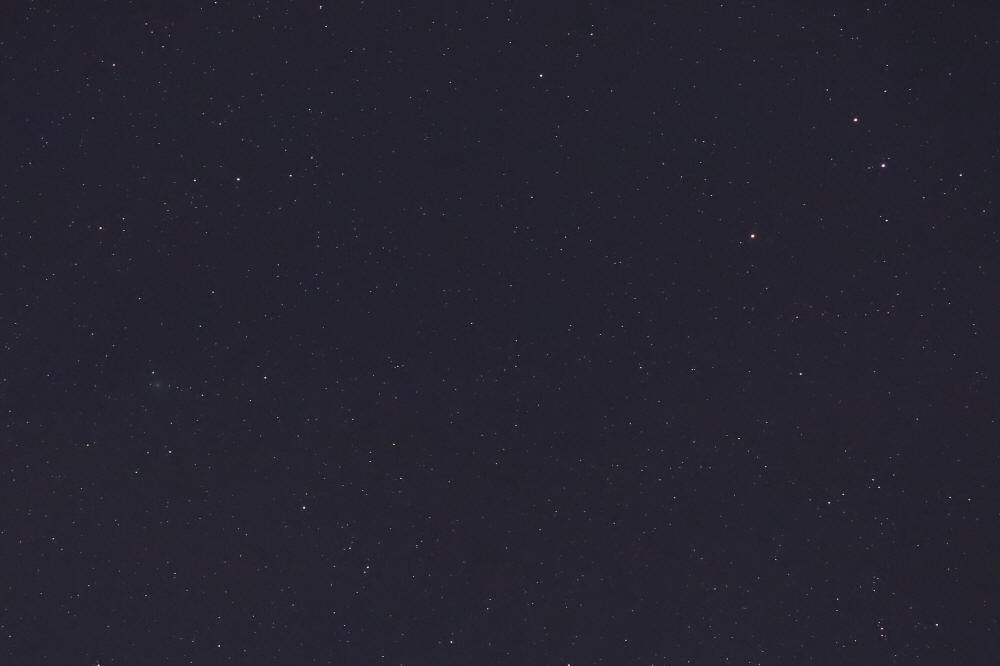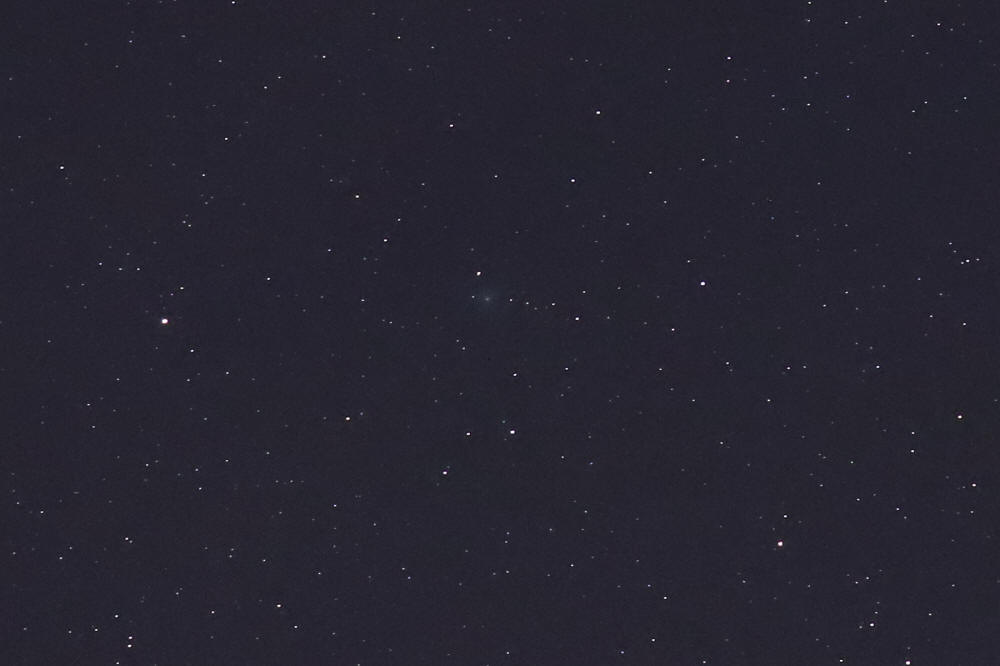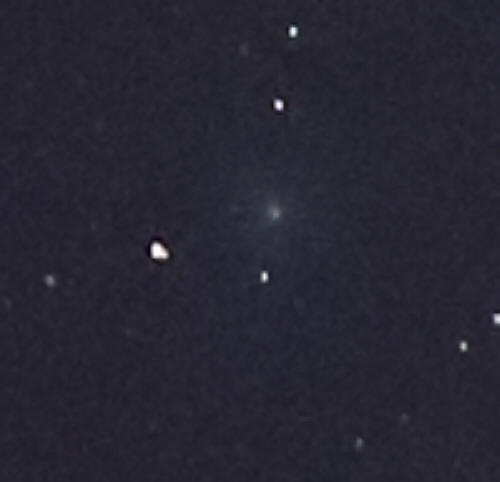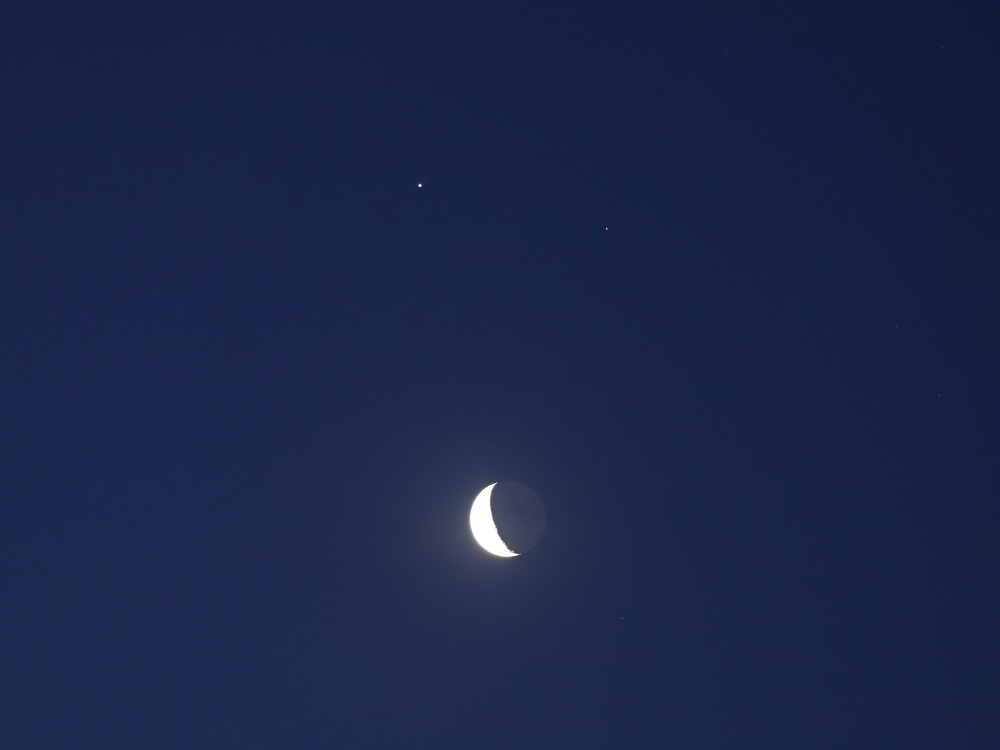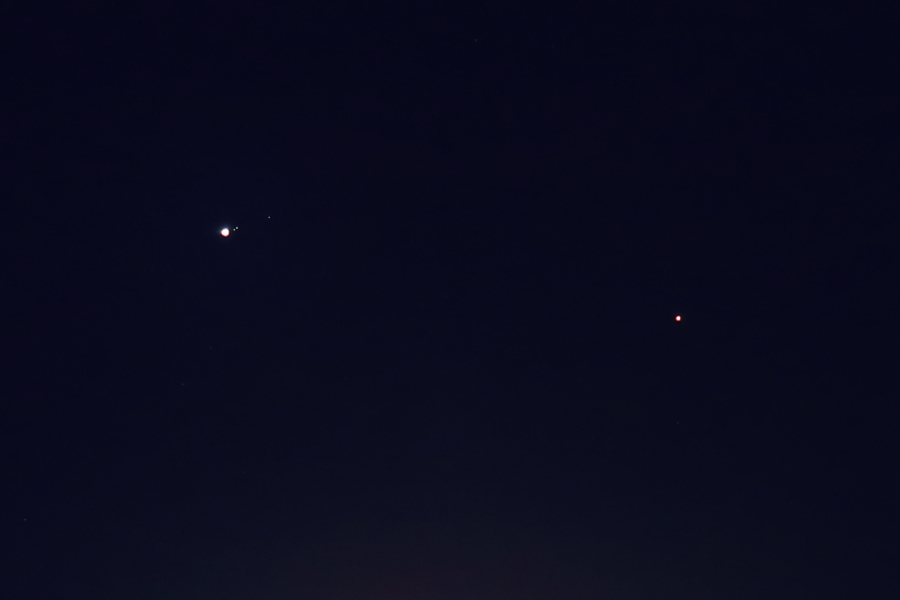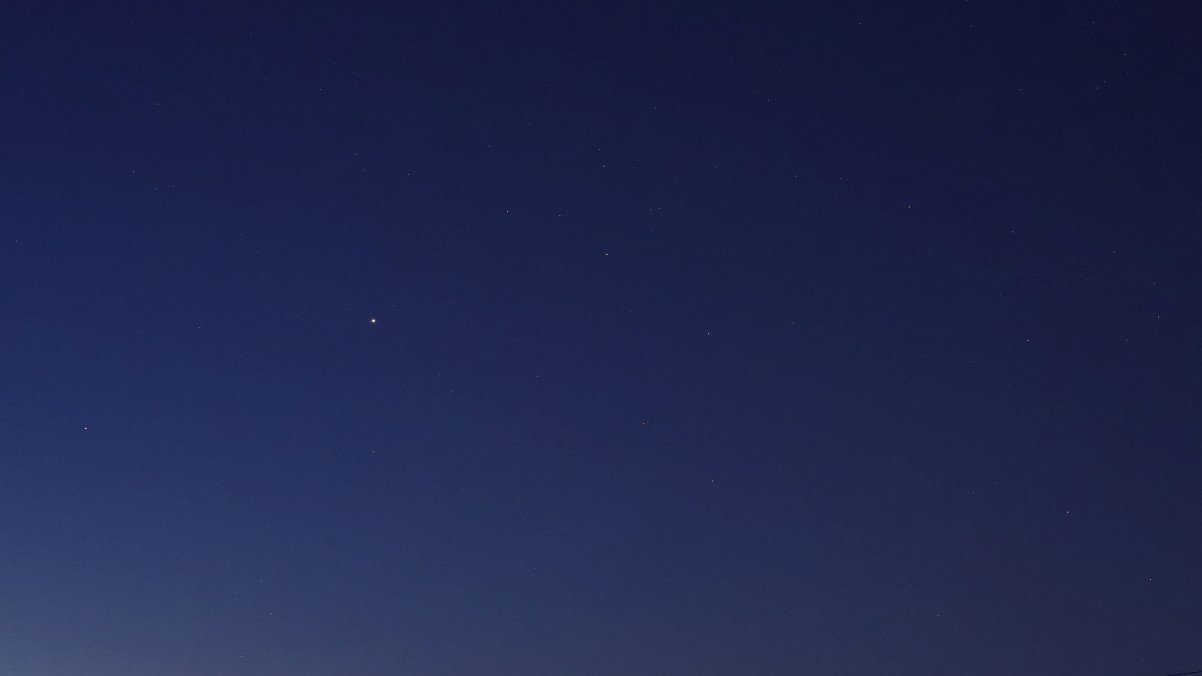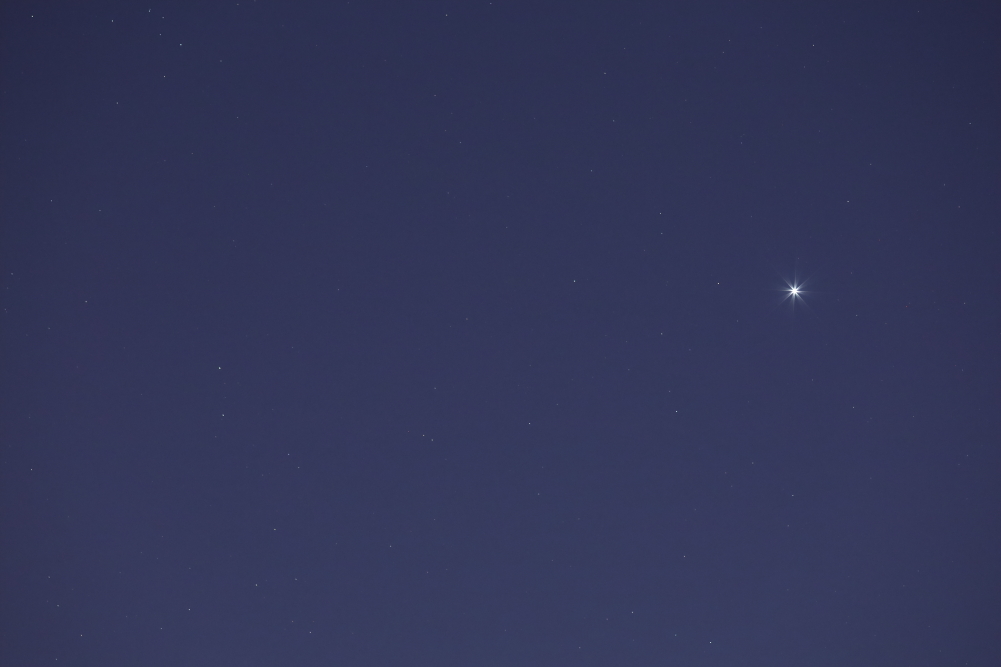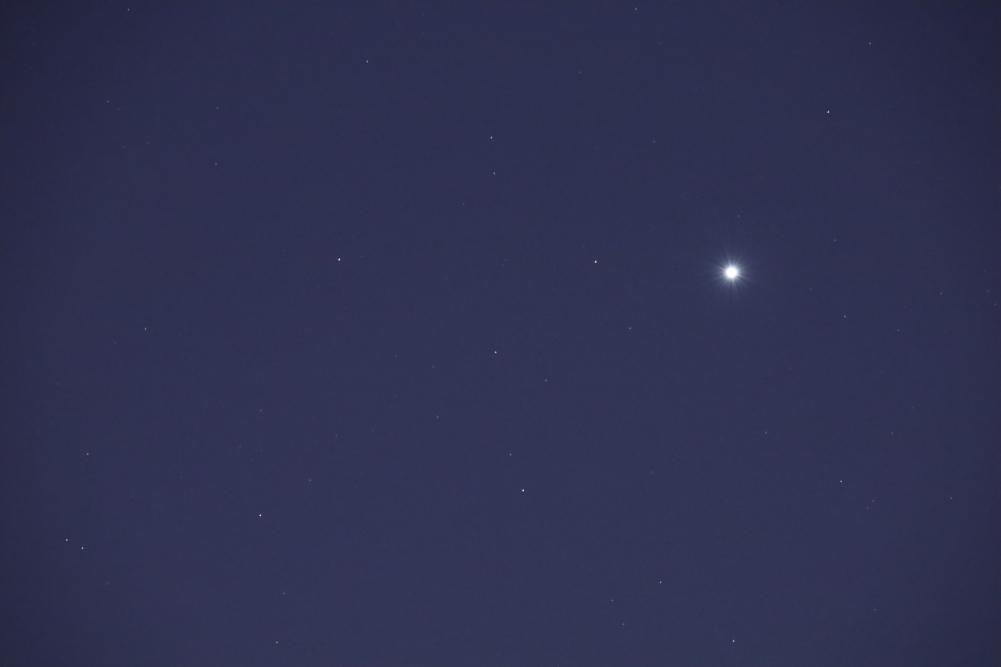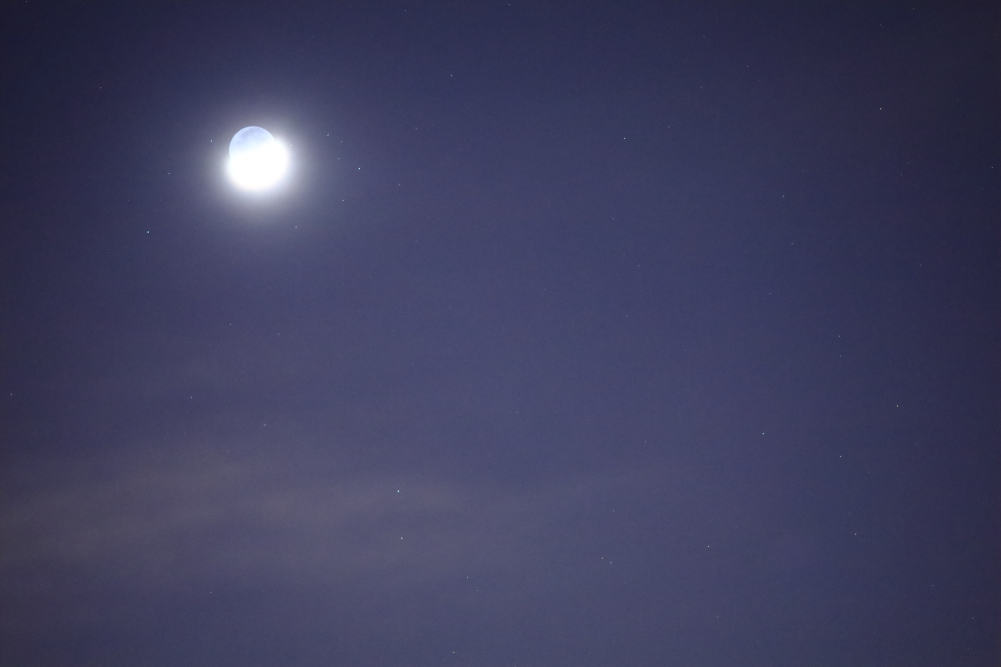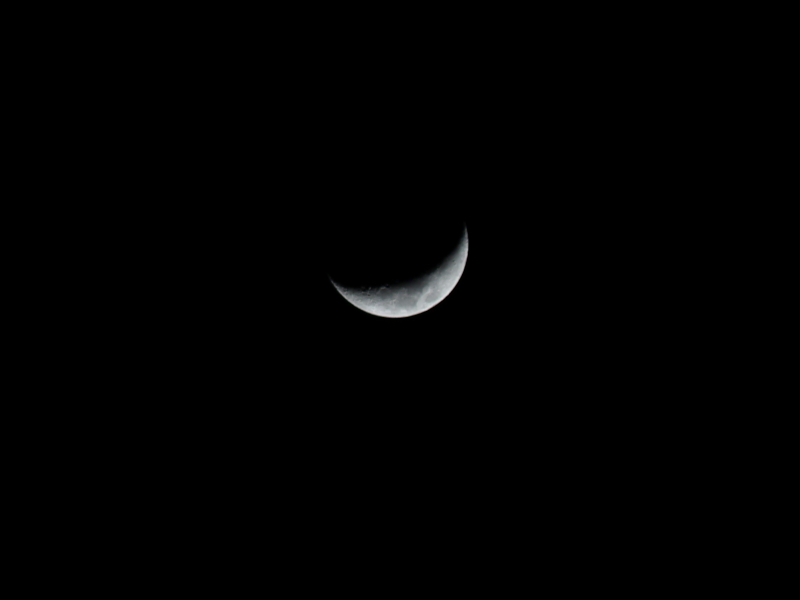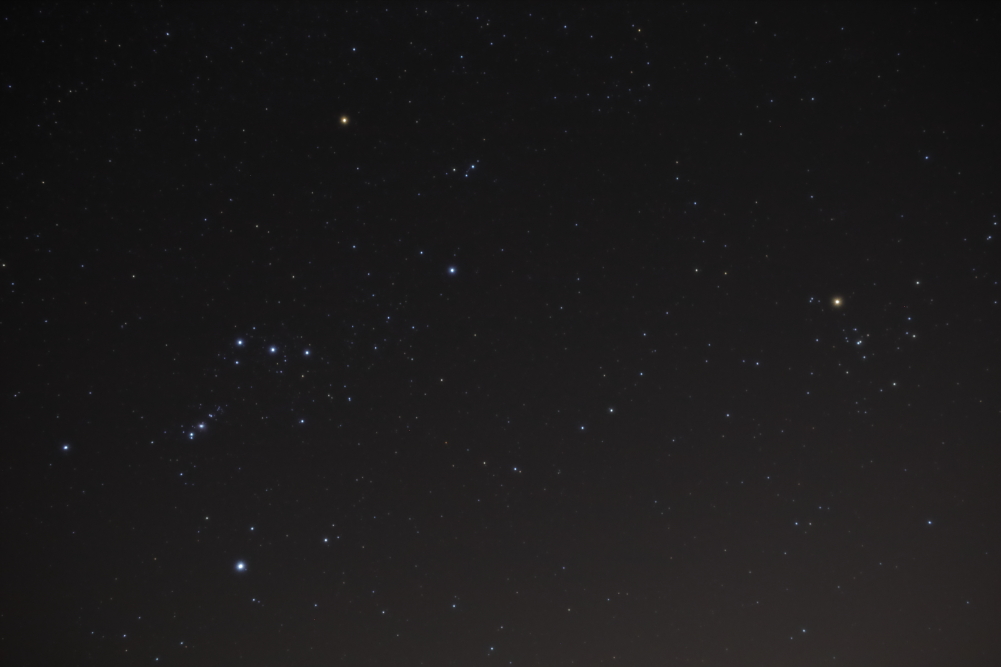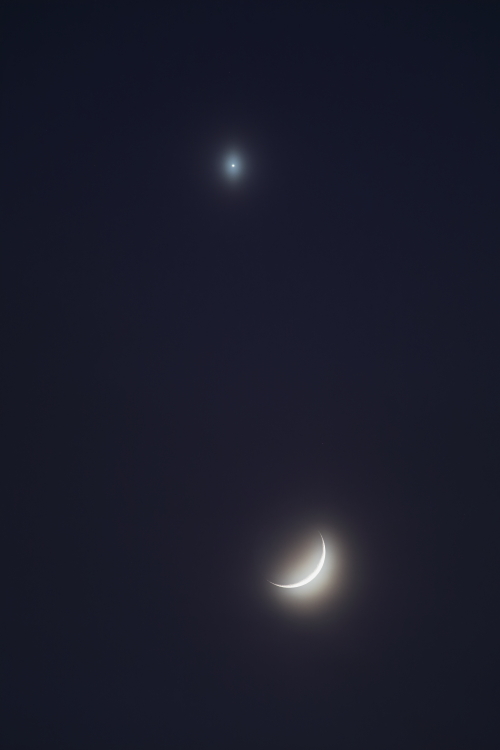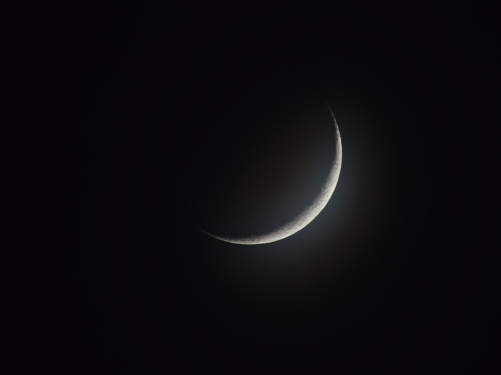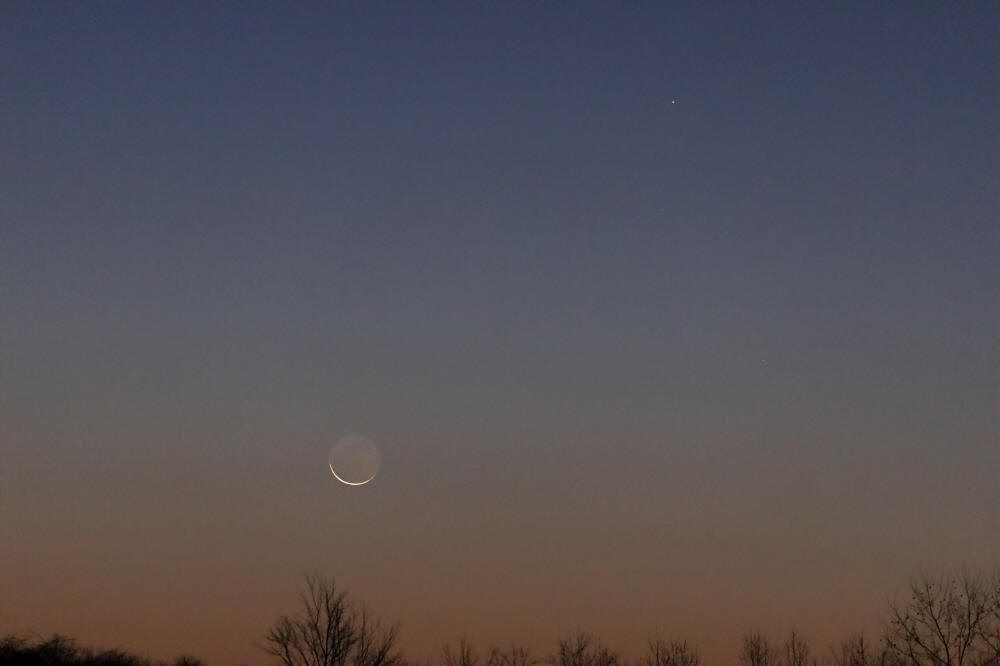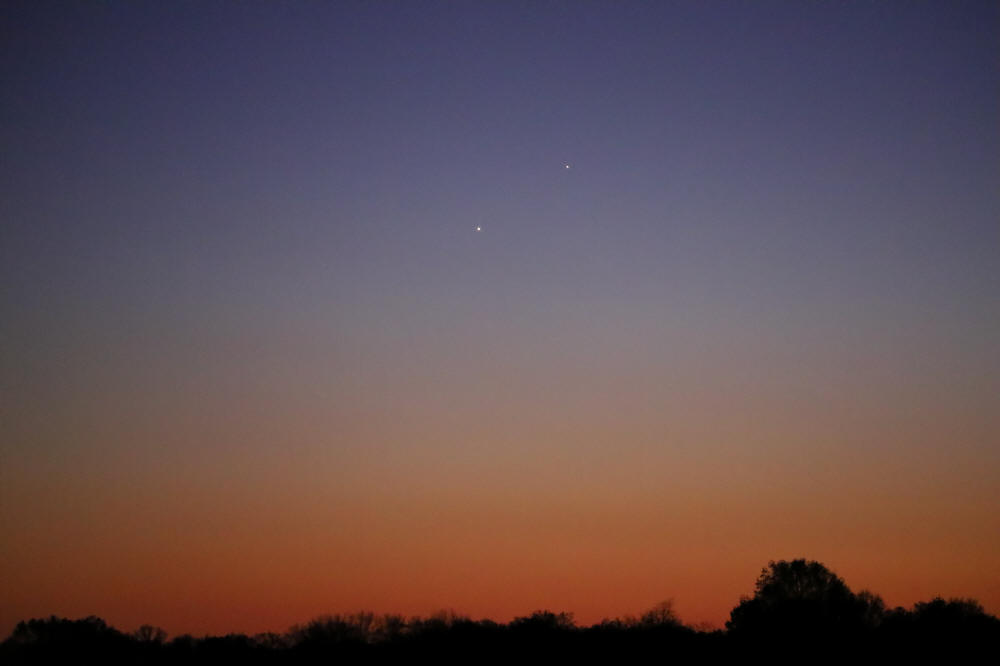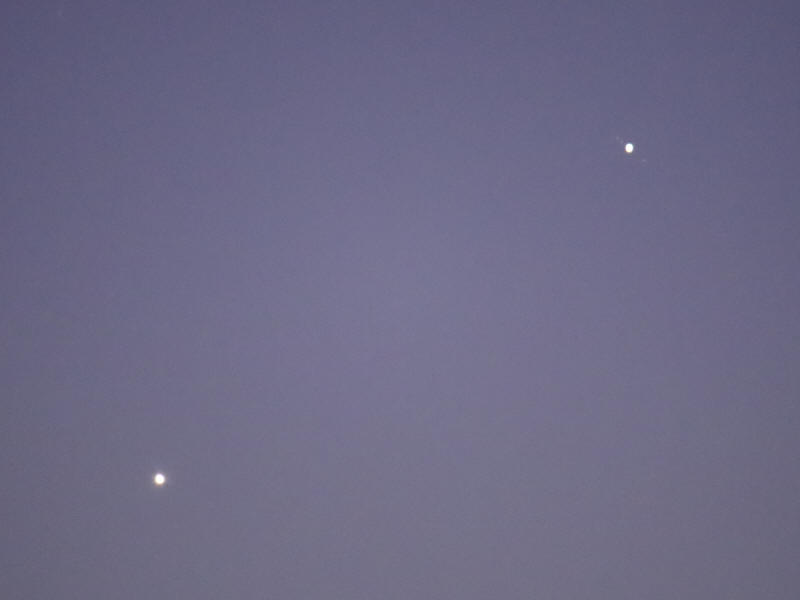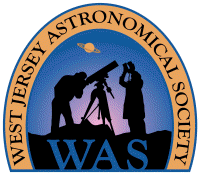SJAstro Page Index |
Mercury 2020, last sighting May
26 |
C/2020 F8 (SWAN),
Altitude May/June 2020,
Magnitude
Comet C/2019 Y4 (ATLAS)
I finally spotted
Comet C/2019 Y4 (ATLAS) at 8:55 pm EDT on
March 27, 2020, with 15x56 binoculars (then
subsequently with 16x70 binoculars and an 88 mm apo spotting scope) from
the New Jersey Pines. The degree-long triangle
formed by Rho, Sigmač and SigmaČ Ursae Majoris was a handy unaided-eye reference for
locating the comet about 3.7° west of Rho. The image above was captured at 9:29 pm
with a Canon EOS RP mirrorless digital camera and a Canon 200 mm f/2.8L
telephoto lens (on a fixed tripod). It's a single raw frame exposed 3.2
seconds at f/3.2, ISO 10,000. The image was cropped
to 58% of the original size for a field 5.9° wide x
4.0° high. The original raw frame was
set to 3600K white balance then cropped and converted to a JPEG in Canon's Digital Photo
Professional.
Mouseover for labels.
Observing was somewhat hampered by the persistent passing of cirrus
clouds, and the transparency wasn't ideal in between clouds. As a
result, the observed comet was just a dim patch of haze (not greatly
unlike its appearance in these snapshots).
Magnitude estimates for C/2019 Y4 were concurrently around 8, and it
may become
visible with unaided eyes in May 2020, but keep in mind that comet brightness
predictions are usually fraught with uncertainties. Indeed, by early
April 2020, it became apparent that the steep upward slope of the
brightness curve had flattened out, and not long afterwards, started
heading down, while images of the comet started showing fragment
shedding. It may or may not be disintegrating, but it now seems very
unlikely this comet will become spectacular as many hoped, and it
probably won't even reach naked-eye brightness.
This image is the same raw frame as above,
but cropped to 29% of the original linear size for a field 3.0° wide x 2.0°
high. Mouseover for labels.
Finally, a severe crop, about 5% of the linear dimensions of the
original raw image, then rotated 90° counterclockwise. This was done to
approximately match an image of Y4 at another message board, primarily
with regard to the multiple star at the 8 o'clock position from the
comet. That star is HD 69804 or SAO 14520. The trio is STF 1208A, B &
C. Per SkyTools, A+B are magnitude 8.43+13.6, 9.6" separation and 146°
PA, while
A+C are magnitude 8.43+10.8, 19.9" separation and
336° PA. In this view, C can be seen as a distinct bump at the
bottom-right of A, and B is perhaps a slight bulge at the upper-left of A. I
believe I saw A & C in the 88 mm spotting scope, but I should have paid
closer attention to them.
Jupiter, Mars and the Crescent Moon
The waxing
The image below better shows
Jupiter
and Mars on
March 18. It was captured in a darker sky at
6:18 am EDT with the same equipment as above. It's a single raw frame exposed 1/5
second at f/2.8, ISO 800, auto white balance, then cropped to 24% of the
original frame for a field 2.5° wide x
1.7° high. Again, Canon's DPP was used for cropping, resizing and
conversion to a JPEG. Mouseover for
labels. Note that the somewhat overexposed "discs" of Jupiter and
Mars look larger than they really are for several reasons (atmospherics,
optics never being perfect, light spill from saturated pixels, etc.).
Therefore, even though Jupiter's actual apparent diameter as given on
mouseover is about the same as the spacing between Io and Ganymede, the
Jovian disc in the picture looks a bit larger than that spacing.
Saturn, Jupiter and Mars
The planets
Saturn,
On March 18, Jupiter,
Mars and the Crescent Moon will be
close together, close enough to all
fit in a typical binocular field. Mars and Jupiter will be at
conjunction on March 20,
then Mars and Saturn will be at conjunction on
March 31, less than a
degree apart on both occasions. Mars is moving relatively quickly
eastward along the ecliptic now. Jupiter is moving eastward more slowly,
and Saturn even slower (generally, as they do go through retrograde
loops around opposition), and they will be at conjunction on
December 21, 2020,
just 0.1° apart. Note that December 21 is also the day of the solstice,
the winter solstice for the northern hemisphere.
Venus and Uranus
This weekend, the brilliant planet
Venus, magnitude -4.3, was passing near the distant and
dimmer Uranus, magnitude
+5.9, a difference of 10.2 magnitudes, or 12,000x in brightness. This image of them was captured at 7:21 pm EST on
March 7, 2020, from Collins Lane Park in Maple
Shade, NJ, with a Canon EOS RP mirrorless digital camera and a Canon 200
mm f/2.8L lens (on a fixed tripod). It's a single raw frame exposed 1.0
second at f/4.0, ISO 3200 and 3800K white balance. This image is
uncropped for a field 10.3° wide x 6.9° high with the planets 2.3° apart. The original raw frame was
resized and converted to a JPEG in Canon's Digital Photo professional,
but otherwise, it's unprocessed. Mouseover for labels. It was
not difficult to see Uranus with 15x56 binoculars using Venus as a
guide.
The planets
Venus and Uranus
were imaged again at 7:33 pm EST with the same Canon RP camera, but using
a Tamron 150 to 600 mm f/5-6.3 zoom lens (on a fixed tripod) set to 350 mm focal length for
an uncropped field 5.9° wide x 3.9° high. It was exposed 2.0 seconds at
f/8.0, ISO 6400 and 3800K white balance (the same net exposure as the
previous image). The original raw frame was resized and converted to a
JPEG in Canon's Digital Photo professional, but otherwise, it's
unprocessed. Mouseover for labels.
The Crescent Moon and Uranus
The
Crescent Moon, 5.4 days old and 24% illuminated, was 6°
from the magnitude 5.8 planet Uranus at
8:37 pm EST on
February 28, 2020, when they were captured from
Collins Lane Park in Maple Shade, NJ, with a Canon EOS RP mirrorless digital camera and a
Canon 200 mm f/2.8 lens (on a fixed tripod). It's a single raw frame exposed
0.3 seconds at f/2.8,
ISO 6400, 3800K white balance. The illuminated crescent is greatly overexposed in order to
show dim Uranus in a murky sky. After mild adjustment, the image was resized and converted to a JPEG in
Canon's Digital Photo Professional. It's uncropped, providing a field
about 10.3° wide x 6.9° high. At the time, the Moon was in the constellation Cetus the Whale, not a Zodiacal constellation (the moon was at 4.5°S
ecliptic latitude), while Uranus was in Aries the Ram, one of the
traditional constellations of the Zodiac . Mouseover for labels,
but note that labels for Xič and XiČ Ceti are
reversed. Uranus
was also spotted with 15x56 binoculars shortly after arrival, about 8:30 pm.
The image below shows the
Moon separately captured at 8:37 pm EST with the same
equipment, but at a significantly reduced exposure to properly show the
crescent. It's a single raw frame exposed 1/125 second at f/4.0, ISO 100, about 12.3 fewer stops, or 5,000x less light than the previous frame,
so earthshine is no longer visible and the background sky is black.
No adjustments were made, except for cropping, size reduction and
conversion to a JPEG in Canon's Digital Photo Professional. The field is
about 2.6° wide x 2.0° high.
Venus at Chatsworth Lake
The planet
Venus shines brightly (magnitude -4.0), even through some cloudiness,
looking southwest across Chatsworth Lake, where it reflects as a
"glitter path" at the bottom of the frame. This image of it was
captured at 6:48 pm EST on
January 15, 2020, from the Pinelands in Chatsworth, NJ, with a Canon EOS RP mirrorless digital camera
(on a fixed tripod) and a Sigma 50 mm f/1.4 Art lens. It's a single raw frame exposed
1 second at f/2.0,
ISO 12,800, then mildly adjusted (including setting white balance to
tungsten), resized and converted to a JPEG in Canon's Digital
Photo Professional. It's uncropped, providing a field 27° wide x 40° high.
Mouseover for labels.
The Hunter Chases the Bull
The constellation
Orion the Hunter chases his prey,
Taurus
the Bull (mouseover for labels). This image of them was
captured at 1:58 am EST on
January 2, 2020, from Carranza Field in
Wharton State Forest, NJ, with a Canon EOS RP mirrorless digital camera
(on a fixed tripod) and a Sigma 50 mm f/1.4 Art lens through a Hoya
"diffuser" filter. It's a single raw frame exposed 2 seconds at f/2.0,
ISO 3200, auto white balance, then resized and converted to a JPEG in
Canon's Digital Photo Professional. It's uncropped, providing a field
40° wide x 27° high.
Betelgeuse, the
reddish star at the upper-left corner of the Orion stick figure, has
recently shown a
noticeable drop in brightness.
Venus and the Crescent Moon through Clouds
Shrouded by some halo-producing cloudiness, the young Crescent Moon,
2.7 days old and 7.4% illuminated, joined the bright planet
Venus in Capricornus on the evening of
December 28, 2019. This image of them was
captured at 5:33 pm EST from the baseball field complex in Maple Shade, NJ, with a Canon EOS RP mirrorless digital camera
and a Canon 400 mm f/5.6L lens (on a fixed tripod). It's a single raw frame
exposed 0.8
second at f/5.6, ISO 1600, daylight white balance, then mildly adjusted,
resized and converted to a JPEG in Canon's Digital Photo Professional.
It was not cropped, providing a field 3.4° wide x 5.1° high. At the
time, the two objects were 2.7° apart and approximately 15° altitude.
The Crescent Moon below was from another image
captured at 5:35 pm with the same equipment, but exposed 0.6 seconds at
f/5.6, ISO 800, then processed in Digital Photo Professional to reduce
the brightness and the cloud halo so that a little of the crater detail would
show in the illuminated area. It was cropped to a field 1.35° wide x
1.0° high.
C/2017 T2 (PANSTARRS) Observed
Third-party images and some background information
are
posted here.
Mercury and the Old Moon
The old Crescent Moon
(lower left) joined the planet
Mercury (upper right) on the morning of
November 24, 2019. This image of them was
captured at 6:03 am EST from Swede Run in Moorestown, NJ, with a Canon EOS RP mirrorless digital camera
and a Canon 200 mm f/2.8 lens (on a fixed tripod). It's a single raw frame automatically exposed 1/30
second at f/2.8, ISO 12,800, daylight white balance, then mildly
adjusted in Canon's Digital Photo Professional. Not cropped for a field
10.3° wide x 6.9° high. At the time, these two objects were 5.1° apart,
the Moon at 4.3° altitude and Mercury at 8.5° altitude. The old Moon was
28 hr 03 min before new (Nov 26, 10:03 am EST), and is 1.7% illuminated.
Mercury was 50% illuminated and magnitude -0.31.
Venus and
Jupiter
The planets
Venus (lower left) and
Jupiter (upper right) were
slightly less than 1.5° apart when they were captured on
November 24, 2019, at 5:27 pm EST from Swede Run
in Moorestown, NJ. Taken with a Canon EOS RP mirrorless digital camera
and a Tamron 150 to 600 mm f/5.0-6.3 zoom lens (on a fixed tripod) set
to 150 mm focal length. It's a single frame automatically exposed 1/20
second at f/5.0, ISO 12,800, daylight white balance, then mildly
adjusted in Canon's Digital Photo Professional. Not cropped for a field
13.6° wide x 9.2° high. These two planets reached conjunction in
geocentric right ascension at 9 am EST on November 24, 1.4° apart.
This view of Venus (lower
left) and Jupiter (upper
right) was captured two minutes earlier, at 5:25 pm EST on
November 24, 2019, with the same camera and lens
as the previous image, but the focal length was set to 600 mm, and then
it was cropped to about 60% of the original size at a 4:3 ratio,
yielding a field 2.0° wide x 1.5° high. Several of Jupiter's satellites
are visible, from the upper left, Europa, Io (Jupiter) and Ganymede.
Callisto was close to Ganymede and is not readily separable here
(vibration from a stiff breeze didn't help). It's a single frame
automatically exposed 1/13 second at f/6.3, ISO 12,800, daylight white
balance, then mildly adjusted in Canon's Digital Photo Professional.
At the time, Venus was at magnitude -3.9 and Jupiter at -1.9 (so Venus
was 6.3x brighter). Venus was at 7° altitude and Jupiter at 7.8°
altitude. A line through the Jovian satellites was nearly parallel to
the ecliptic. Jupiter had a +0°09' ecliptic latitude while Venus was at
-1°16' ecliptic latitude.
Click here
for the previous page.
Click here
for an index to previous SJAstro pages.
March 27, 2020
March 18, 2020
March 8, 2020
March 7, 2020
February 28, 2020
January 15, 2020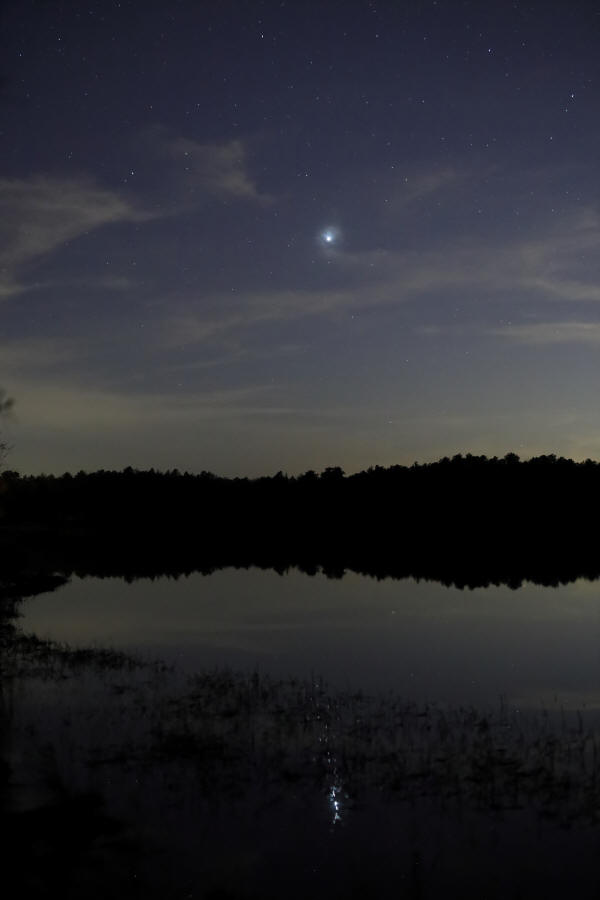
January 2, 2020
December 28, 2019
December
15 & 21, 2019
November 25, 2019
November 24, 2019
